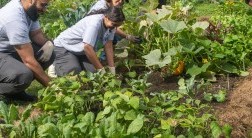Saving seeds is a global effort of immense importance. But home gardeners should also institute this practice—not so much as an insurance policy against floods, famine, or doomsday, but as a way to save natural resources and money, and as a means to become more in tune with the life of the garden. Saving seeds from successful crops is relatively easy and ensures continuity in your garden from year to year.
First, here are a few general tips on seed saving:
- Don’t save seeds from hybrid plants. The seeds tend to create offspring that aren’t true to their parents, or they may even be sterile.
- Be careful with cross-pollinating plants like spinach, peppers, squash, and melons. If planted too closely together, different varieties of these plants can cross with each other, resulting in mixed-heritage offspring. Collect seeds from cross-pollinators only if they have been grown with significant space between them.
- Biennials don’t produce seed stalks until their second season, so plants like carrots, cabbage, turnips, beets, brussels sprouts, onions, parsnips, and Swiss chard need to be carefully coaxed through their first year so that they’ll bear seed in their second.
- Perennials should be propagated via cuttings or divisions—save your seed saving for annuals and biennials.
A Practice Run: Tomatoes
Non-hybrid tomatoes are a great source of seeds and one of the easiest vegetables to practice seed saving on. (Eggplant, beans, watermelons, and summer squash are other plants that make for simple seed saving.) Since tomatoes self-pollinate, you don’t have to worry about cross-pollination, and the seeds you collect this year should produce plants just like their parents.
If you’ve ever eaten a tomato, you know that tomato seeds are covered in a wet, gooey coating, so you need to process them first in order to separate fertile seeds from infertile ones, kill off viruses, and prevent seeds from rotting during storage. Here’s how you do it:
- Start with ripe, fully mature tomatoes. Scoop out the seeds with their goopy coating and put them in a bowl with some water (about one cup of water per each tomato).
- Keep this mix at room temperature (about 65°–70°F) for two days. By doing this, you’re enabling the fermentation of the seeds’ gooey coating, and as with all fermentation, this might emit some stinky fumes.
- At the end of two days, infertile seeds and the gelatinous seed coating should rise to the top, and fertile seeds should sink to the bottom of the bowl. Pour off the water, goo, and infertile seeds, and keep the fertile seeds.
- Now rinse the fertile seeds well in a strainer with lots of running water to remove any remaining tomato pulp.
- Spread the seeds on a clean nylon window screen, and put this in a warm location to dry the seeds.
- Once they are dry, store the seeds in an airtight container in a cool, dry, dark place like the refrigerator where they’ll stay ready to use for next year’s planting.
To learn how to save other vegetable seeds, visit one of many excellent online resources, such as the International Seed Saving Institute, which offers tips on how to collect and process seeds from 27 common vegetables.
Another excellent source of information on seed saving is right here at Brooklyn Botanic Garden—just give a call to the Garden’s community greening team at 718-623-7250. Brooklyn Botanic Garden offers a remarkable repository of gardening tips, and the staff there can help you troubleshoot your tomato-seed harvest.
Share Your Seeds
Once you start collecting and storing vegetable seeds, you may soon find yourself up to your ears in them. This is a good thing! There are many outlets for sharing those seeds with others. Many local community gardens sponsor seed swaps, where you can exchange seeds with other gardeners in your area. For more information about seed swaps or starting your own, visit Food Not Lawns Seed Swap and Project Grown, a community gardening program in Ann Arbor, Michigan. To transact your seed sharing online with a national community, join the Seed Savers Exchange.
Start your seed-saving project small by collecting from a few of your favorite vegetable plants—and soon enough you might just be swapping with the best of them.
Additional Resources:Community Gardening, edited by Ellen Kirby and Elizabeth Peters (Brooklyn Botanic Garden, 2008): This all-region handbook from BBG includes information about seed saving and swapping for community gardeners.
Food Not Lawns: How to Turn Your Yard into a Garden and Your Neighborhood into a Community, by H.C. Flores (Chelsea Green, 2006): The chapter “Seed Stewardship” instructs on everything from what tools the home gardener needs for seed saving to how to start a community seed swap.
Seed to Seed: Seed Saving and Growing Techniques for Vegetable Gardeners, by Suzanne Ashworth (Seed Savers Exchange, 2002): With instructions on how to save seeds from over 160 vegetables, the second edition of Seed to Seed is an essential reference for seed savers.



